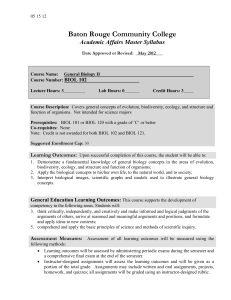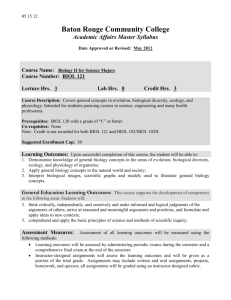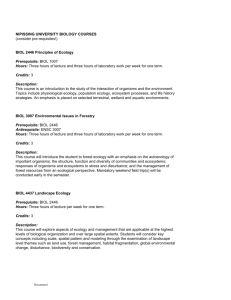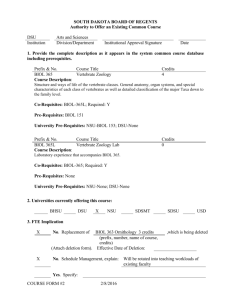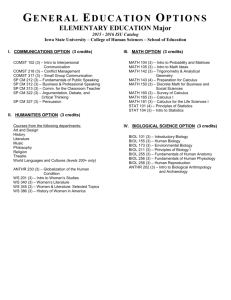Conservation Ecology Curriculum
advertisement
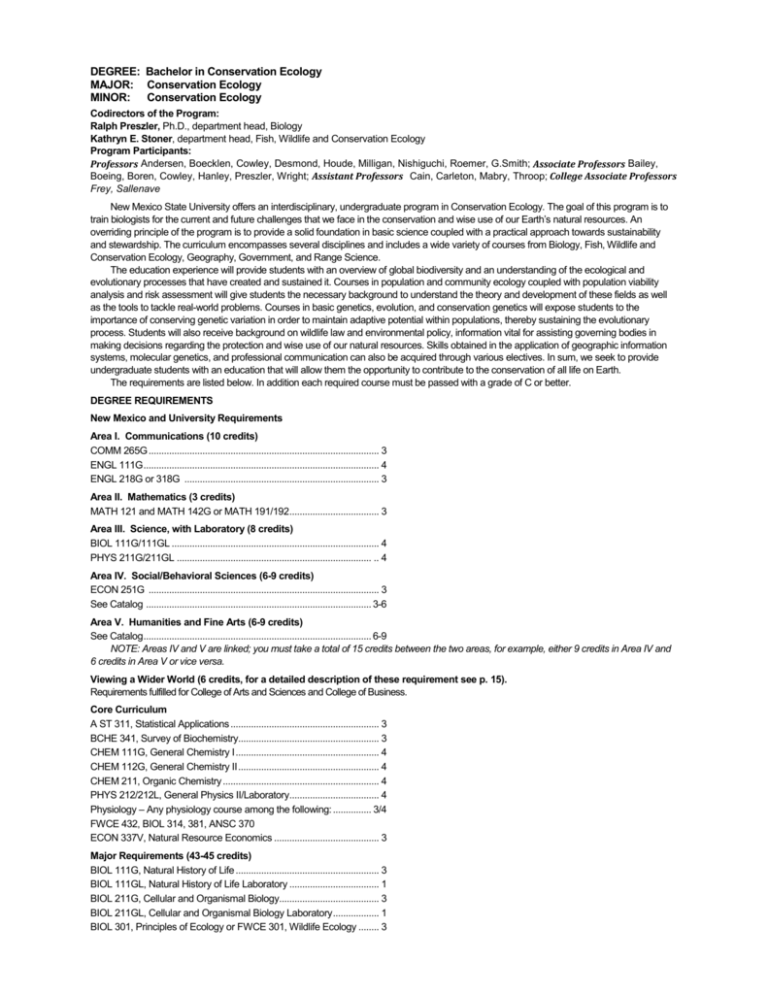
DEGREE: Bachelor in Conservation Ecology MAJOR: Conservation Ecology MINOR: Conservation Ecology Codirectors of the Program: Ralph Preszler, Ph.D., department head, Biology Kathryn E. Stoner, department head, Fish, Wildlife and Conservation Ecology Program Participants: Professors Andersen, Boecklen, Cowley, Desmond, Houde, Milligan, Nishiguchi, Roemer, G.Smith; Associate Professors Bailey, Boeing, Boren, Cowley, Hanley, Preszler, Wright; Assistant Professors Cain, Carleton, Mabry, Throop; College Associate Professors Frey, Sallenave New Mexico State University offers an interdisciplinary, undergraduate program in Conservation Ecology. The goal of this program is to train biologists for the current and future challenges that we face in the conservation and wise use of our Earth’s natural resources. An overriding principle of the program is to provide a solid foundation in basic science coupled with a practical approach towards sustainability and stewardship. The curriculum encompasses several disciplines and includes a wide variety of courses from Biology, Fish, Wildlife and Conservation Ecology, Geography, Government, and Range Science. The education experience will provide students with an overview of global biodiversity and an understanding of the ecological and evolutionary processes that have created and sustained it. Courses in population and community ecology coupled with population viability analysis and risk assessment will give students the necessary background to understand the theory and development of these fields as well as the tools to tackle real-world problems. Courses in basic genetics, evolution, and conservation genetics will expose students to the importance of conserving genetic variation in order to maintain adaptive potential within populations, thereby sustaining the evolutionary process. Students will also receive background on wildlife law and environmental policy, information vital for assisting governing bodies in making decisions regarding the protection and wise use of our natural resources. Skills obtained in the application of geographic information systems, molecular genetics, and professional communication can also be acquired through various electives. In sum, we seek to provide undergraduate students with an education that will allow them the opportunity to contribute to the conservation of all life on Earth. The requirements are listed below. In addition each required course must be passed with a grade of C or better. DEGREE REQUIREMENTS New Mexico and University Requirements Area I. Communications (10 credits) COMM 265G .......................................................................................... 3 ENGL 111G ............................................................................................ 4 ENGL 218G or 318G ............................................................................ 3 Area II. Mathematics (3 credits) MATH 121 and MATH 142G or MATH 191/192................................... 3 Area III. Science, with Laboratory (8 credits) BIOL 111G/111GL ................................................................................. 4 PHYS 211G/211GL ............................................................................ .. 4 Area IV. Social/Behavioral Sciences (6-9 credits) ECON 251G .......................................................................................... 3 See Catalog ........................................................................................ 3-6 Area V. Humanities and Fine Arts (6-9 credits) See Catalog......................................................................................... 6-9 NOTE: Areas IV and V are linked; you must take a total of 15 credits between the two areas, for example, either 9 credits in Area IV and 6 credits in Area V or vice versa. Viewing a Wider World (6 credits, for a detailed description of these requirement see p. 15). Requirements fulfilled for College of Arts and Sciences and College of Business. Core Curriculum A ST 311, Statistical Applications .......................................................... 3 BCHE 341, Survey of Biochemistry....................................................... 3 CHEM 111G, General Chemistry I ........................................................ 4 CHEM 112G, General Chemistry II ....................................................... 4 CHEM 211, Organic Chemistry ............................................................. 4 PHYS 212/212L, General Physics II/Laboratory................................... 4 Physiology – Any physiology course among the following: ............... 3/4 FWCE 432, BIOL 314, 381, ANSC 370 ECON 337V, Natural Resource Economics ......................................... 3 Major Requirements (43-45 credits) BIOL 111G, Natural History of Life ........................................................ 3 BIOL 111GL, Natural History of Life Laboratory ................................... 1 BIOL 211G, Cellular and Organismal Biology....................................... 3 BIOL 211GL, Cellular and Organismal Biology Laboratory .................. 1 BIOL 301, Principles of Ecology or FWCE 301, Wildlife Ecology ........ 3 BIOL 305 or AGRO 305, Principles of Genetics ................................... 3 BIOL 467, Evolution ............................................................................... 3 BIOL 312, Plant Taxonomy, or RGSC 307, Rangeland Grasses, AND RGSC 316, Rangeland Plants ..................................................... 3 BIOL 313, Structure and Function of Plants.......................................... 3 BIOL 322, Zoology ................................................................................. 3 FWCE 255, Principles of Fish and Wildlife Management ..................... 3 FWCE 330, Natural History of the Vertebrates ..................................... 4 FWCE 402, Seminar in Natural Resource Management ..................... 1 FWCE 409, Introduction to Population Ecology, or BIOL 470, Developmental Biology 3 FWCE 462 or BIOL 462, Conservation Biology.................................... 3 Requirements in Diversity of Life: Any two courses (6-8 credits) BIOL 465, Invertebrate Zoology ............................................................ 4 BIOL 480, Animal Behavior ................................................................... 3 EPWS 303, Economic Entomology....................................................... 4 FWCE 430, Avian Field Ecology, or BIOL 447, Ornithology ................ 4 FWCE 431, Mammalogy ....................................................................... 3 FWCE 482, Ichthyology ......................................................................... 3 Additional courses Electives to bring total to 128 credits including 54 upper division credits Recommended Electives BIOL 488, Principals of Conservation Genetics or FWCE 488, Conservation Genetics 3 BIOL 489, Genetic Aspects of Population Biology................................ 3 FWCE 464, Management of Aquatic and Terrestrial Ecosystems ...... 3 GEOL 381, Cartography and Geographic Information Systems.......... 3 GEOG 481, Fundamentals of Geographic Information Systems......... 3 Other Related Courses GEOL 111G, Survey of Geology ........................................................... 4 GEOL 295, Environmental Geology ...................................................... 3 GEOL 424, Soil Chemistry..................................................................... 3 GOVT 378, U.S.-Mexico Border Politics ............................................... 3 HIST 401, American Environmental History ......................................... 3 RGSC 318, Watershed Management ................................................... 3 RGSC 325, Rangeland Restoration Ecology........................................ 3 RGSC 452, Rangeland Analysis ........................................................... 3 TOX 423, Environmental Toxicology..................................................... 3 MINOR: Conservation Ecology A minor in conservation ecology is available for students who choose to major in other areas, but wish to include conservation ecology in their academic training. The minor must include a minimum of 20 credits in the discipline with 9 of these coming from upper-division courses. Requirements Core Curriculum (17 credits) BIOL 111G, Natural History of Life ........................................................ 3 BIOL 111GL, Natural History of Life, Lab .............................................. 1 FWCE 301, Wildlife Ecology or BIOL 301, Principles of Ecology ........ 3 FWCE 462 or BIOL 462, Conservation Biology ................................... 3 FWCE 330, Natural History of the Vertebrates ..................................... 4 Conservation (3 Credits) BIOL 467, Evolution ............................................................................... 3 BIOL 488, Principles of Conservation Genetics .................................... 3 FWCE 409, Introduction to Population Ecology.................................... 3 FWCE 464, Management of Aquatic and Terrestrial Systems ............ 3

